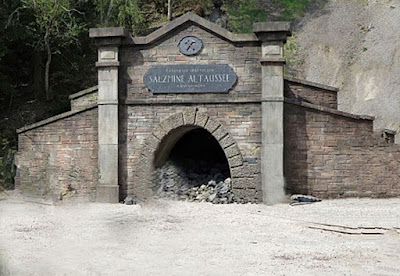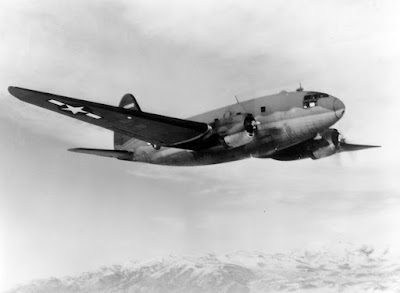July 24, 2021
PROTECT THE TREASURE
On April 13, 1945 the Alt Aussee mine was visited by Martin Bormann’s secretary, Dr. Helmut von Hummel, with orders for August Eigruber, the Nazi official in charge of the region: “the artwork was by no means to fall into enemy hands, but in no event should it be destroyed.”
 |
| Bormann was head of the Nazi Party Chancellery and Adolf Hitler's private secretary. |
Eigruber said that he did not believe these new secret orders, even though he was told they came directly from Martin Bormann. “The main point is total destruction,” he said. “On this point we will remain bull-headed.” He added that he would “personally come and throw grenades into the mine” if he had to.
Alerted to Eigruber’s intransigence, one of the German officers in charge of the art at the Alt Aussee, together with two miners, and an assistant followed the mountain passages into the mine, circumventing the guards at the entrance. Inside, they secretly moved the most valuable of the artworks stored in the mine to a separate location – the subterranean Chapel of Saint Barbara, which miners had built in 1935 and dedicated to Saint Barbara, patron saint of miners. It was the sturdiest space in the mine, least likely to be damaged by bombs set off in the storage chambers nearby. The first item transferred was The Ghent Altarpiece.
On May 3, the leader of the miners reached out to the most powerful Nazi official in the area – SS chief Ernst Kaltenbrunner, Heinrich Himmler’s number two. He told Kaltenbrunner about Eigruber’s direct disregard for von Hummel’s orders. Kaltenbrunner granted permission for the bombs Eigruber had placed earlier to be removed.
Eigruber still planned to send a detachment of soldiers to the mine, where they would destroy the art inside by hand if necessary. The destruction of the world’s art treasures would be Eigruber’s final legacy.
Aware of what the Eigruber might do, the mine’s foreman, Otto Hogler, sealed Alt Aussee so the art treasures could not be reached. Six tons of explosives sealed the tunnels into the Alt Aussee salt mine, the world’s greatest museum of stolen art. There was nothing now that Eigruber could do to harm what lay locked inside.
RESCUING THE TREASURE
On May 7, 1945, the Germans surrendered unconditionally. The war in Europe was over.
On May 8, the first American troops arrived at the mine. The 80th U.S. Infantry took over the protection of the mine.
On May 16, word reached Monuments Men Robert Posey and Lincoln Kirstein that the mine had been secured by the Allies and the Resistance, and they rushed to the scene. On May 17, the debris which blocked the entrance to the mine was cleared and Posey and Kirstein were the first to step inside.
As they explored cavern after cavern, the extent of the hoard came quickly to light. Three-quarters of a mile into the mine, a cavern referred to as the Kammergraf, housed multiple galleries of art, each one three stories tall. Another of the caverns, the Springerwerke, 50 feet long and 30 feet wide, contained 2,000 paintings.
Then they came upon the Chapel of Saint Barbara, where Hermann Michel had hidden a few of the most treasured pieces. There, unwrapped were eight panels of Jan van Eyck’s Adoration of the Mystic Lamb.
The soldiers and miners spent four days cataloguing the stolen hoard. In all, the Alt Aussee treasure consisted of:
♦ 6,577 oil paintings
♦ 2,030 works on paper (watercolors and drawings)
♦ 954 prints (etchings and engravings)
♦ 137 statues
♦ 128 pieces of arms and armor
♦ 79 containers full of decorative arts
♦ 78 pieces of furniture
♦ 122 tapestries
♦ 1,500 cases of rare books
These objects included works by most of the greatest artists in history: Van Eyck, Michelangelo, Vermeer, Rembrandt, Rubens, Titian, Tintoretto, and more. There were hundreds of 19th century German paintings, as well as Egyptian tomb statuary, Greek and Roman busts and marble sculptures, bronzes, porcelain, inlaid wood furniture, ornate tapestries – the finest content of the looted museums, galleries, and private collections of Nazi-occupied Europe.
The rescued art work was sent to a collection point at Munich where they were to be retrieved by representatives from each victimized country. General Eisenhower personally requested the immediate restitution of selected masterpieces, at U.S. expense, as evidence of American policy. Jan van Eyck’s Adoration of the Mystic Lamb was very first of these most important artworks to be returned.
 |
| Hofbrau House where the recovered art work was assembled |
On August 21, 1945, a chartered plane was to fly the altarpiece from Munich to Brussels. A parade and grand welcome waited at Brussels airport.
After 500 years of kidnaping, smuggling, dismemberment, looting, successful and attempted vandalism, ransom, near destruction, and a dizzying array of thefts, The Adoration of the Mystic Lamb was safely on its way home. But true to the history of The Lamb, the trip would not be a smooth one.
 |
| The Ghent Altarpiece, with Robert Posey who accompanied it on its flight home. |
Next week, “Homecoming,” and the conclusion of the saga of The Ghent Altarpiece.
👉 Today’s close is once again from Praying with the Psalms, by Eugene H. Peterson, as we continue in Psalm 119.
“I rise before dawn and cry for help; I put my hope in your words” (Psalm 119:147).
“The early morning belongs to the church of the risen Christ” (Dietrich Bonhoeffer, Life Together). Christians, from the beginning, have encouraged one another to offer their first words, their first thoughts, the first moments of silence each day, to the Lord of creation.
Prayer: “As the sun doth daily rise, brightening all the morning skies, so to Thee with one accord lift we up our hearts, O Lord! Praise we, with the heavenly host, Father, Son, and Holy Ghost; Thee would we with one accord praise and magnify O Lord” (“As the Sun Doth Daily Rise,” Latin hymn). Amen.
-30-







No comments:
Post a Comment